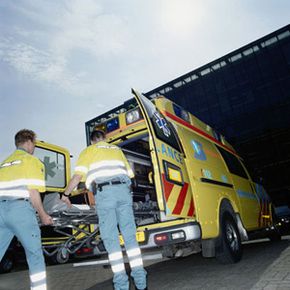From the second 911 operators pick up their phones, they know they're working against the clock to avert an emergency situation or to save a life. The operators can try to assist you from the other end of the phone line, but it's the first responders to the scene who have a chance to assess the situation and begin medial treatment. These responders -- emergency medical technicians or EMTs -- could be faced with situations ranging from a pregnant woman in labor to someone with a severe gunshot wound [source: US Labor].
The EMTs use their training to assess the situation and then control bleeding, administer intravenous fluids, perform CPR or use other basic life support techniques on the scene. Then, as the patient is transported to a hospital, the EMTs continue to administer care. Once the patient arrives at the hospital's emergency department, it's important for any observations gathered at the scene to be reported to the hospital staff [sources: US Labor, Become an EMT].
Advertisement
Being an EMT is not without mental pressure or great responsibility; as a first responder your job is literally to help save lives. But the importance of the work is what makes being an EMT rewarding. And you don't have to give up your current career to be a part of this worthwhile profession. Every day, volunteer EMTs are called upon to respond to emergency medical situations.
Volunteer opportunities can be found through Volunteer EMS, an online directory of emergency medical providers in 37 states in the United States. Or, to find opportunities in your area, check with nearby colleges and universities. Many of them have emergency medical service (EMS) organizations that need volunteer EMTs on standby at college events such as concerts or football games [sources: University of Minnesota, Campus].
In this article, you will find information on the standard requirements, training and benefits of working as a volunteer EMT.
If you are interested in volunteering as an EMT, but aren't sure if you qualify for the job, see the next page for some of the basic requirements.
Advertisement



